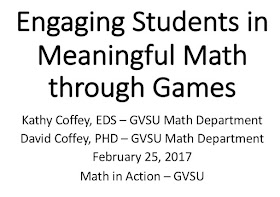Our presentation from Math in Action 2017
Description:
Games are an effective
way
to engage students in learning. Participants will experience how to support the
development of pre-adolescent mathematicians through purposeful play. [Grades 3-5]
Consider what you think it means to effectively teach mathematics. Now take the Simile Survey provided below. What are the characteristics of your simile selection that relate to good mathematics teaching?
A while back, Dr. Doug Fisher introduced me to another teaching simile: Teaching is like being an expert commentator. During the lesson, the teacher highlights important aspects of the "routine" that the student might otherwise overlook. In cases where the action moves too quick, the teacher might need to "rewind and show it in slow motion" in order to clarify some move. Here is an example from the 2016 U.S. Olympic Trials that demonstrates these characteristics. So what does this look like in math class?
Imagine we are in a 3rd-grade class playing BINGO. If the students are fluent in reading number symbols, there's not much to the game. So let's break it - add another dimension by allowing players to decompose the number that's called.
If you were in a 5th-grade class, they might ask why they can't decompose the called number into more than two addends ... or use operations other than addition. Then the challenge might be, "Can I get a BINGO with just one number called?"
After (or during the game), what sorts of things would you want the students to notice? What would you highlight and maybe have to slow down? It depends on the game and our players.
- If I was playing the regular game of BINGO with young kids still struggling with number recognition, I might be sure to call "thirteen" and highlight ways to tell the difference between 13 and 31.
- If we are decomposing, I might want kids to recognize that 38 can be decomposed into 30+8 or 31+7 and highlight the concept of compensation.
- For 5th graders, I might show how "thirteen" can be written as 13+8/(9-7)-4 and highlight an important property of zero in our number system. [To demonstrate another important property of zero, ask students if they could cover the entire board if "thirteen" was called.]
It is important that teachers have the opportunity to play games before using them with their students. That way the teachers can consider possible modifications (ways to "break" the game) that would meet their students' needs. It also gives them experience playing the games that can lead to insights into important mathematical aspects encountered while playing that the teachers might want to highlight for their students.
Game Centers
Number and Operations - Fractions
Grades 3-5
- Fraction Go Fish
- Fraction Memory [pdf]
- Cookie Fractions [page36]
- DecimalPickle
- Pattern Block Fraction Game
- Fraction Track [app]
=====
Other Game Resources
- Adventures with Mathematics [MCTM]
- Gameswith Fraction Strips and Fraction Cards
- Rational Number Resources [NRICH]
- Investigations Games
=====
After playing the games, we reflect on our experiences using Math Teacher Chair:
- What games did you play?
- So what mathematical ideas would you want to highlight?
- Now what would you do to break the game or slow down the play so students would benefit mathematically from playing?
Thanks for your participation. You can reach us using the following contact information.
"Rocket science is child's play
compared to understanding child's play."
~ Unknown
If you are attending the upcoming 2017 NCTM Annual Meeting and Exposition in San Antonio, we will be presenting this session again.
We promise it will be better next time thanks to the feedback you've provided on your session evaluations (or in the comments below).












